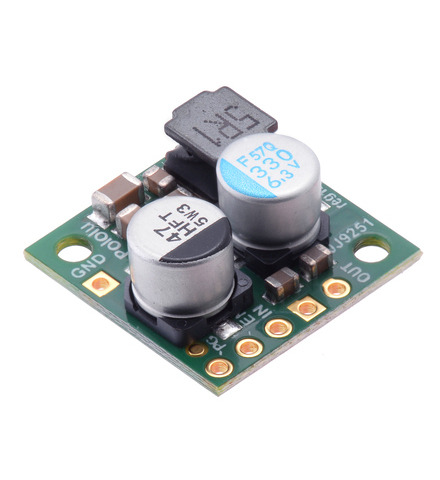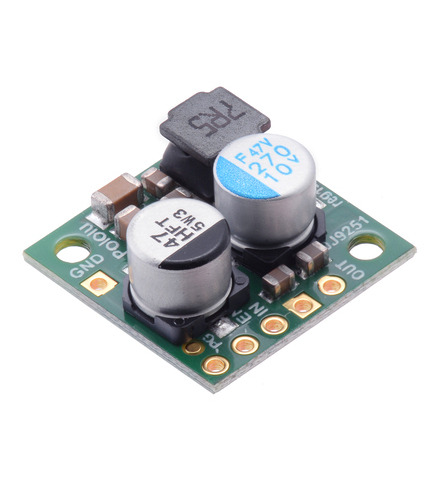The D24V22Fx family of step-down voltage regulators generates lower output voltages from input voltages as high as 36 V. They are synchronous switching regulators (also called switched-mode power supplies (SMPS) or DC-to-DC converters) with typical efficiencies of 85% to 95%, which is much more efficient than linear voltage regulators, especially when the difference between the input and output voltage is large. These regulators can typically support continuous output currents of over 2 A, though the actual available output current is a function of the input voltage and efficiency (see the efficiency graphs on the product pages).
The modules have built-in reverse-voltage protection, short-circuit protection, a thermal shutdown feature that helps prevent damage from overheating, and a soft-start feature that reduces inrush current.
| Regulator |
Output voltage |
Typical max output current1 |
Input voltage range2 |
Size |
Special features |
Price |
| #2857: D24V22F3 |
3.3 V |
2.6 A |
4 V – 36 V |
0.7″ × 0.7″ |
Reverse voltage protection,
short-circuit protection,
thermal shutdown,
soft-start |
$18.95 |
| #2858: D24V22F5 |
5 V |
2.5 A |
5.3 V – 36 V |
$18.95 |
| #2859: D24V22F6 |
6 V |
2.5 A |
6.4 V – 36 V |
$19.95 |
| #2860: D24V22F7 |
7.5 V |
2.4 A |
8 V – 36 V |
$19.95 |
| #2861: D24V22F9 |
9 V |
2.3 A |
9.6 V – 36 V |
$19.95 |
| #2855: D24V22F12 |
12 V |
2.2 A |
12.7 V – 36 V |
$19.95 |
| Note 1: At 24 V in. Actual achievable maximum continuous output current is a function of input and output voltage and is limited by thermal dissipation. See the output current graphs on the product pages for more information. |
| Note 2: Minimum input voltage is subject to dropout voltage considerations; see the dropout voltage section of product pages for more information. |
 Compare all products in this category
Compare all products in this category
Products in category “D24V22Fx Step-Down Voltage Regulators”
| Output voltage |
Typical max output current1 |
Input voltage range2 |
| 3.3 V |
2.6 A |
4 V – 36 V |
Note 1: At 24 V in. Actual achievable maximum continuous output current is a function of input voltage and is limited by thermal dissipation. See the output current graphs on the product pages for more information.
Note 2: Minimum input voltage is subject to dropout voltage considerations; see the dropout voltage section of product pages for more information.
| Output voltage |
Typical max output current1 |
Input voltage range2 |
| 5 V |
2.5 A |
5.3 V – 36 V |
Note 1: At 24 V in. Actual achievable maximum continuous output current is a function of input voltage and is limited by thermal dissipation. See the output current graphs on the product pages for more information.
Note 2: Minimum input voltage is subject to dropout voltage considerations; see the dropout voltage section of product pages for more information.
| Output voltage |
Typical max output current1 |
Input voltage range2 |
| 6 V |
2.5 A |
6.4 V – 36 V |
Note 1: At 24 V in. Actual achievable maximum continuous output current is a function of input voltage and is limited by thermal dissipation. See the output current graphs on the product pages for more information.
Note 2: Minimum input voltage is subject to dropout voltage considerations; see the dropout voltage section of product pages for more information.
| Output voltage |
Typical max output current1 |
Input voltage range2 |
| 7.5 V |
2.4 A |
8 V – 36 V |
Note 1: At 24 V in. Actual achievable maximum continuous output current is a function of input voltage and is limited by thermal dissipation. See the output current graphs on the product pages for more information.
Note 2: Minimum input voltage is subject to dropout voltage considerations; see the dropout voltage section of product pages for more information.
| Output voltage |
Typical max output current1 |
Input voltage range2 |
| 9 V |
2.3 A |
9.6 V – 36 V |
Note 1: At 24 V in. Actual achievable maximum continuous output current is a function of input voltage and is limited by thermal dissipation. See the output current graphs on the product pages for more information.
Note 2: Minimum input voltage is subject to dropout voltage considerations; see the dropout voltage section of product pages for more information.
| Output voltage |
Typical max output current1 |
Input voltage range2 |
| 12 V |
2.2 A |
12.7 V – 36 V |
Note 1: At 24 V in. Actual achievable maximum continuous output current is a function of input voltage and is limited by thermal dissipation. See the output current graphs on the product pages for more information.
Note 2: Minimum input voltage is subject to dropout voltage considerations; see the dropout voltage section of product pages for more information.
 Compare all products in this category
Compare all products in this category































